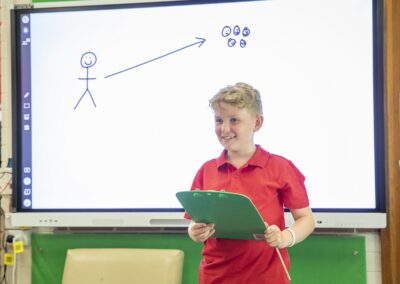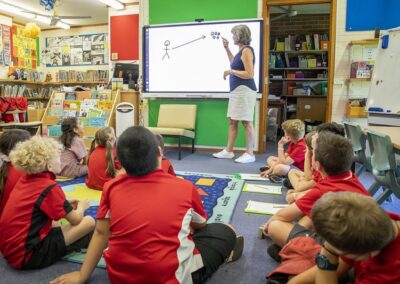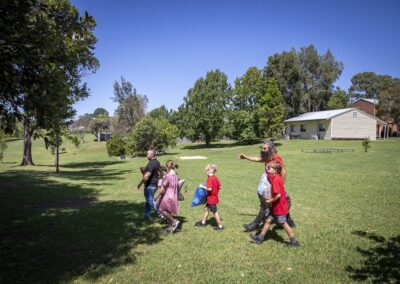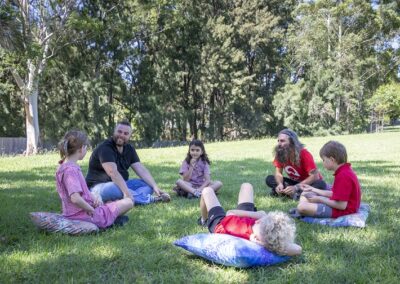LEARNING ACTIVITY
STORY
Jarrah was always interested in the yarning circle area at the National Arboretum in Canberra, Ngunnawal/Ngambri Country.
He felt that such a space likely held importance to his people but wasn’t sure why. He decided to ask Adam, a Wiradjuri man living on Ngunnawal/Ngambri land, the next time they explored the garden together.
Adam: “Hi Jarrah! How are you bud? Ready to learn more about some of the plants in the garden here?”
Jarrah: “Hi Uncle, I sure am, but I wanted to ask about that yarning circle area. I always feel a connection there. Is it something our ancestors would use?”
Adam: “Yes, yarning circles are important to us culturally. They are used as a place to discuss issues, share knowledge and stories, and much more. This one at the Arboretum has been built by machines and with some of the local Elders’ input, but we would have these spaces naturally on country, too. Sometimes our old people would just sit in a circle in the sand or dirt to conduct these circles; other times, like in the high country here, they would sit on large boulders and stones that helped.”
Jarrah: “Wow, that sounds like an important practice. Maybe it’s something I can do with my friends at school?”
Adam: “Excellent idea! Yarning circles are great to have in a school. You can go there for a yarn, brainstorm ideas, or even fix problems. Have a chat with your teachers and give me a yell if you need a hand.”

This activity introduces children to the idea of a yarning circle and its importance in First Nations Culture.
This activity is the first activity in an 8-part activity sequence that has been developed to help you design, build and use a yarning circle in your space. The order of these learning activities are: background, site selection, involving First Nations people, building the yarning circle, connecting to Landcare, using the yarning circle, yarning circle activities and yarning and wellbeing.
For children to:
- understand the concept of a yarning circle
- learn how a yarning circle was and is still used today
- appreciate how being in a circle allows everyone to be seen and heard.
This activity can be undertaken at any time of the year.
Introduction
Building a yarning circle is a great way to create a space that is inviting and connects children to the outdoors. This space can be used by your class or youth group to yarn about important issues in an informal setting, and to learn more about the Cultural practices and teachings of Aboriginal and Torres Strait Islander peoples.
For First Nations people, the yarning circle was and still is an important place to conduct business, talk about issues in the community or on Country, and have a space where all voices are recognised and heard.
“We understand that what was spoken in the circle stayed there, unless it was necessary to take any information away like decisions on Cultural practices for another setting,” explains Adam Shipp, First Nations educator and proud Wiradjuri man.
“Our old people would sit or stand barefoot on the earth, on the dirt, which itself provided a healing and safe environment, and our mother earth provided grounding and strength through direct connection. These are practices that can be adopted in our schools today – and will help with mental, physical and spiritual wellbeing.
“We create this area to be a safe place for all; a place where all people have a chance to yarn on equal terms.”
Establishing a yarning circle in your school or community also provides an opportunity to create an outdoor learning space that will help immerse children in nature. We often think of nature as being separate to us; out in the ‘bush’ far away from our towns and cities. However, when you take the time to sit and observe everything around you, you will soon start to recognise the scents and colours of the trees, plants and flowers in your school; the sounds of the birds that visit those plants; and the insects that many of those birds and smaller animals will feed on. You may be surprised at just how much you can see, smell and hear just by sitting in your yarning circle or outdoor area.
Checklist
Instructions

Step 1
Introduction:
Begin this activity with an Acknowledgement of Country. By acknowledging the Land, you are also making a promise that you will recognise the Cultural practices of First Nations people.
Use the story above to introduce the topic of a yarning circle.
Have a discussion with students about what they know about yarning circles, including what they were and are still used for today.
Remind children of the different ways we can communicate with one another e.g. verbal and non-verbal communication.

Step 2
Mapping:
Next, discuss how a teacher or facilitator’s position standing in front of a class or group may affect these types of communication.
Use a whiteboard to map the direction of communication. Use a bird’s-eye view with dots to show the teacher/facilitator and the students. Use different coloured whiteboard markers to draw arrows to show the direction of the verbal and non-verbal communication. (Much of it will be back and forth.)
Ask the question: How much do we communicate or listen to each other when we are assembled like this (in a circle)?
Then ask how much we communicate and listen to one another when someone is positioned in front of a class or group of people.

Step 3
Predicting differences:
Head outside. As a group, find a suitable place to sit in a circle, like under the shade of a tree. This could even be where you would like to set up your yarning circle.
Sit in a circle.
Ask students to form pairs so they can predict together (turn-and-talk) how sitting in a circle could affect or improve communication (verbal and non-verbal).
Hand out the Activity sheet and clipboards so they can record their predictions.
Explain that as a group, you will be sharing your predictions from the turn-and-talk activity, and you will also be recording the direction of discussion as well as non-verbal communication, such as eye contact.

Step 4
Recording results:
Ask the children to represent each person in the group by drawing circles or dots on the sheet.
As each pair reports their ideas from the ‘turn-and-talk’ activity, ask the students to map the direction of the communication after each group’s turn.
At the end of the discussion, ask the students to share their communication maps.
Record any additional results, such as whether it was easier to understand what was said or how body language was observed during this sharing time.
As a group, reflect on your results and take a moment to consider why yarning circles are an important part of First Nations Culture and can be beneficial for different types of communication.
Extension Activity
Create a class list about the different types of verbal and non-verbal communication we use every day.
Investigate other ways First Nations people share ideas and information and compare their Cultural practices around communication.
Curriculum and Framework Links
SCIENCE
Year 5: ACSHE083
Year 7: ACSHE120
Year 8: ACSHE135
HUMANITIES AND SOCIAL SCIENCES
Year 2: ACHASSI042
Year 3: ACHASSI052, ACHASSI059, ACHASSI060
Year 4: ACHASSI080, ACHASSK088, ACHASSK090
Year 5: ACHASSI102, ACHASSK120
Year 6: ACHASSI122, ACHASSI130
DESIGN AND TECHNOLOGIES
Year 2: ACTDEK003
Year 3 & 4: ACTDEP017
Year 5 & 6: ACTDEP019
Year 7 & 8: ACTDEK032
HEALTH AND PHYSICAL EDUCATION
Year 2: ACPPS018, ACPPS022, ACPPS023
Year 3 & 4: ACPPS036, ACPPS040, ACPPS041
Year 5 & 6: ACPPS054, ACPPS059
Year 7 & 8: ACPPS073, ACPPS078
ABORIGINAL AND TORRES STRAIT ISLANDER HISTORIES AND CULTURES
ETHICAL UNDERSTANDING
Exploring values, rights and responsibilities.
PERSONAL AND SOCIAL CAPABILITY
CURRICULUM CONNECTIONS
CROSS CURRICULUM PRIORITY
MY TIME, OUR PLACE: FRAMEWORK FOR SCHOOL AGE CARE
Reference List
ONLINE RESOURCES
Landcare Australia is proud to acknowledge Aboriginal and Torres Strait Islander peoples as the Traditional Custodians of the Country on which we live and work and have a number of resources to support First Nations perspectives learning.
PRINTABLE RESOURCES
Queensland Family and Child Commission: Printable Yarn Up Cards
WATCH
Discover more about the significance and power of yarning circles in this short video with Uncle Neil Evers, a Garigal man and direct descendent of historical figure and Pittwater Aboriginal clan leader ‘King’ Bungaree.
Watch Principal Mills and Principal Heise speak about the impact yarning circles have had on their students, staff and broader school community.
Check out the Junior Landcare Professional Development Webinar with Junior Landcare ambassador Costa Georgiadis, First Nations educator Adam Shipp and environment education specialist Sam Harrison for more about the importance of embedding First Nations perspectives into everyday learning and how to create a yarning circle.
READ
The SBS NAIDOC Week teacher resource provides a background on the importance of teaching and celebrating First Nations perspectives.
NETWORK
We recommend reaching out to the Local Traditional owners and First Nations peoples community groups who can assist in knowledge sharing and understanding local land, language, stories and culture.
To reach out or find contacts in your local First Nations community you could speak to parents of First Nations students, to an Indigenous Learning Officer (ILO) at your school or to a local Land council.
We have some suggested organisations to approach listed on our Junior Landcare Community page.
We value your feedback
When you have finished this learning activity, please tell us what you think with our survey.
Your feedback will help Landcare Australia improve the activities in the Junior Landcare Learning Centre.
Why not try one of our other Junior Landcare learning activities?
Creating an Indigenous plant-use garden: plant list
First Nations Perspectives
Creating an Indigenous plant-use garden: resources from the bush
First Nations Perspectives
Love Letters to the Land
Biodiversity|First Nations Perspectives|Food Production|Waste Management
Creating a yarning circle: involving First Nations people
First Nations Perspectives